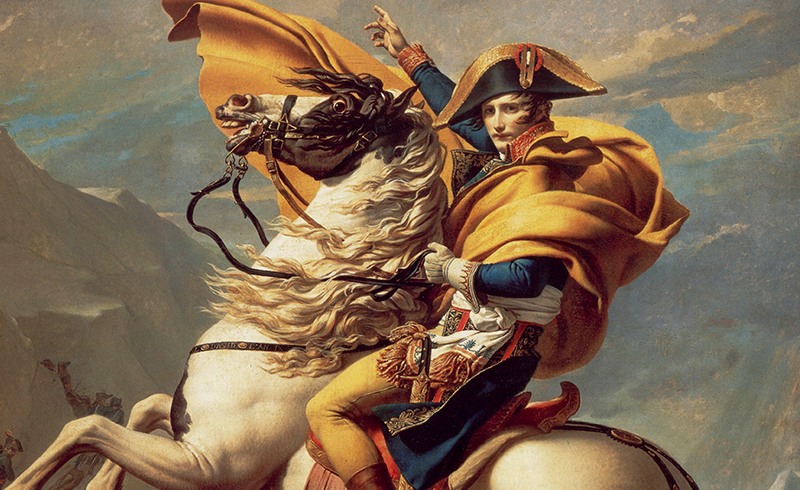
April 5, 2022
Musical Revolution: Beethoven’s Symphony No. 3, Eroica
On April 15 & 16, the Houston Symphony performs Beethoven’s revolutionary Symphony No. 3, Eroica with guest conductor Rafael Payare. In this post, discover how personal crisis and political turmoil combined to inspire one of the most influential pieces of music ever composed. Learn more about this history-making masterpiece in our podcast, On the Music. Get tickets and more information here.

Perhaps no piece of music has been more pivotal in music history than Beethoven’s Third Symphony, a revolutionary work provoked by both personal crisis and geopolitical turmoil. After the French Revolution of 1789 toppled the most powerful monarchy in Europe, many—including Beethoven—began to hope a freer, more egalitarian society would emerge. The ensuing wars and reign of terror threatened these hopes, and Europe waited for a hero to save the revolution. By 1803, when Beethoven wrote his Third Symphony, that hero seemed to have appeared: Napoleon Bonaparte.
Compounding the political crisis that surrounded Beethoven was an internal one—for years, Beethoven had experienced a gradual hearing loss that would eventually render him completely deaf. In 1802, Beethoven wrestled with this terrifying fate. He wrote:
“But what a humiliation for me when someone standing next to me heard a flute in the distance and I heard nothing, or someone heard a shepherd singing and again I heard nothing. Such incidents drove me almost to despair, a little more of that and I would have ended my life. It was only my art that held me back.”
Beethoven resolved to take a “new path” in his music, aspiring to create the symphonic equivalent of a Homeric epic with Napoleon as his subject. The music would be full of raw, wild dissonances and rhythms that could express epic struggle. Once completed, Beethoven would take the symphony to France.
The Music
Like Homer’s Iliad, the first movement begins in the midst of battle with two explosive chords:
After this call to arms, the cellos intone the main idea of the movement. Their deep, rich sound gives the opening idea a masculine character, suggesting that this is the hero. Fragmentary, lyrical ideas vie with more violent ones until a series of disorienting chords leads to a return to the beginning. This repetition (one of Beethoven’s few nods to tradition) allows listeners a second chance to process this complex music before the development begins.

During the tumultuous development, the fragmentary ideas of the exposition interact, building to a crisis. The orchestra lunges from one dissonance to another, climaxing with a harrowing cry. After a pause, a ghostly new theme appears in the oboes. Eventually, the music dies away until a lone horn call signals the heroic theme’s return, and the other main ideas reappear as well. After a reprise of the ghostly theme from the development, the music gradually crescendos as the heroic idea returns in triumph.
The second movement is a reminder of the terrible cost of war. Modeled on funeral marches written in revolutionary France, it begins with a hushed melody for strings; the double basses imitate the drums that would have accompanied a French funeral procession. The movement alternates between music expressing intense grief, bittersweet memories, and heroic commemoration of the dead, building to an intense climax.
The music comes back to life in the third movement, which has been interpreted by some as an expression of soldierly comradery. A solo oboe introduces a rustic melody, and the tune is passed from instrument to instrument like a whispered joke until the full orchestra finally says it out loud. The contrasting middle section features a trio of hunting horns.
The finale, too, begins with a musical joke: a grand flourish leads to an anticlimactic, unadorned bass line. Beethoven drew this bass line from The Creatures of Prometheus, his 1801 ballet about the titan who stole fire from the gods and gave it to humanity, bringing enlightenment to humankind. The movement has thus been interpreted as representing the hero’s works of peace. The rich inventiveness of Beethoven’s imagination is on full display as he transforms the bass line in a series of variations that climaxes with a slow hymn. Beginning with the oboe, more and more instruments take up the hymn, until all play it together. Perhaps this is Beethoven’s vision of a harmonious, creative society at peace.
Never Meet Your Heroes

By May 1804, Beethoven was eager to move to France, but one event upset his plans. Beethoven’s student, Ferdinand Ries related, “At the very top of the title page [of the symphony] stood the word ‘Buonaparte’…I was the first to tell him the news that Bonaparte had declared himself emperor, whereupon he flew into a rage and shouted: ‘So he too is nothing more than an ordinary man. Now he will also trample all human rights underfoot, and only pander to his own ambition; he will place himself above everyone else and become a tyrant.’ Beethoven went to the table, took hold of the title page at the top, ripped it all the way through, and flung it to the floor.”
When the symphony was published in 1806, the title page read: “Sinfonia Eroica, per festeggiare il sovvenire di un grand Uomo,” or “Heroic Symphony, in celebration of the memory of a great man.” In the end, it is likely not Napoleon, but Beethoven’s own personal struggles—especially with his hearing loss—that provided the ultimate inspiration for this revolutionary work. Though it was not his intention, many believe Beethoven himself is the true hero of this “heroic” symphony.
Want to learn more? Dig deeper in our podcast, On the Music.
Don’t miss Beethoven’s Eroica on April 15 & 16! Visit houstonsymphony.org for tickets and more information.
This blog was originally published in April 2019.






